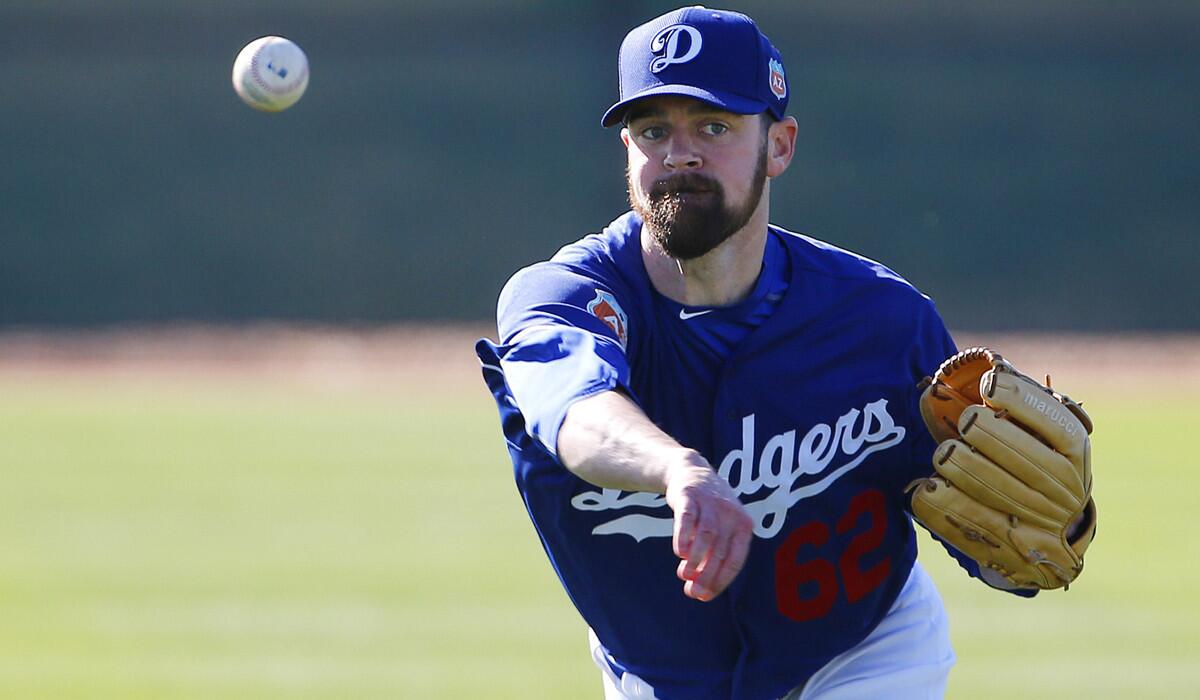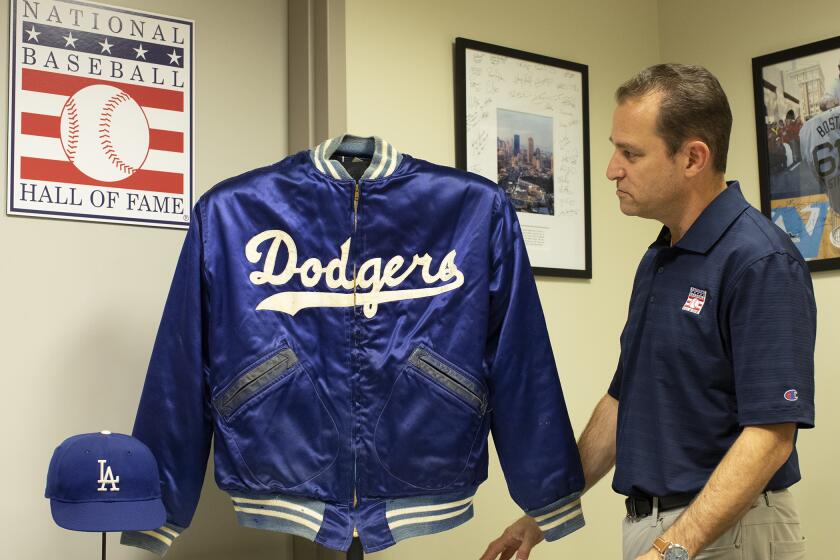Sidearm reliever Louis Coleman is having a sterling spring for the Dodgers

Dodgers pitcher Louis Coleman warms up during a spring training baseball workout on Feb. 22 in Glendale, Ariz.
- Share via
Reporting From PHOENIX — Twenty-three days before he signed with the Dodgers, Louis Coleman flew into Kansas City and checked into a downtown hotel. He was scheduled to sign autographs at a convention center during the final weekend in January with the rest of the World Series champion Kansas City Royals, a group he had watched from afar in October.
Coleman wondered why the organization tendered him a contract over the winter after stashing him in the minors for almost all of 2015, but the phone call he received the next morning still stunned him.
Coleman heard the voice of Royals General Manager Dayton Moore on the other line. Moore apologized profusely for the timing. The team had finalized a contract with a free-agent pitcher, and the deal cost Coleman his roster spot. His schedule suddenly blank, Coleman ventured into the city for lunch.
“Luckily, I was under the radar the whole time I was there,” Coleman said. “So I didn’t run into any fans who were like, ‘Hey, good luck!’ That wasn’t bad. But I ran into all the coaches coming back there. I got that sense that they didn’t know if I knew, but I knew that they probably knew. And so I just acted like nothing happened.”
An afterthought in Kansas City, Coleman has become an object of curiosity with the Dodgers, and a likely member of his new club’s opening-day bullpen. His sidearm delivery flummoxes hitters and improves a bullpen’s stylistic diversity.
In a spring marred by injuries, the relief corps remains intact. The Dodgers did little to augment their bullpen this winter. The team signed only two relievers to major league contracts: Joe Blanton and Coleman, a right-hander who turns 30 next month. Both were refugees from the Royals, whose bullpen was their backbone en route to the past two World Series.
For $4 million, Blanton will operate as a long reliever. His place on the roster looks secure. In seven scoreless outings this spring, Coleman has distinguished himself in a crowded field of middle relievers with a sterling spring.
“He’s done a lot of good things,” Manager Dave Roberts said. “He’s definitely made us have multiple conversations about him.”
The apex of the bullpen is defined. Kenley Jansen is the closer, set up by right-hander Chris Hatcher and left-handers J.P. Howell and Luis Avilan. In the name of depth preservation, the Dodgers could option either Pedro Baez or Yimi Garcia to the minors to retain Coleman.
The Dodgers could attempt to sneak Coleman through waivers and stash him in triple A. The Royals completed a similar maneuver last spring. But given Coleman’s Cactus League performance, that may be difficult.
Coleman has faced 24 batters; three have collected hits. He has struck out 10. His slingshot arm action adds deception to a fastball that rarely hovers above 90 mph, with a hard-breaking slider as his other option.
For a right-handed hitter, “It’s coming from behind you, and it ends up on the outside corner — it’s just hard for you to hang in there,” catcher A.J. Ellis said. For a left-handed hitter, “You’re not used to seeing the ball coming from third base,” Roberts said.
Coleman can command his slider to both sides of the plate, pitching coach Rick Honeycutt explained. The Dodgers asked him to challenge left-handed hitters by throwing inside more often, so hitters cannot sit on the fastball away.
“Watching the guys who face him out there, [they’re] uncomfortable,” Ellis said. “He’s definitely done nothing but make everybody around here open their eyes.”
Coleman displayed this talent in patches with the Royals. He finished the 2013 season with a 0.61 earned-run average in 27 outings. But the next February, he suffered a bruised middle finger on his right hand while fielding a grounder, and “he never really recovered from that,” Kansas City pitching coach Dave Eiland said.
Unable to locate his pitches, Coleman stumbled to a 5.56 ERA in 2014. Coleman did not earn a spot on the big league roster for 2015 and spent almost the entire season in the minors. Even with a 1.69 ERA in triple A, Coleman did not earn a call-up until September.
The Royals did not add Coleman to their postseason roster. Instead, they dispatched him to Arizona to keep his arm fresh in case of emergency. He watched the games at restaurants in Scottsdale.
“It’s one of those bittersweet things,” Coleman said. “Because you have to stay ready. But it’s so hard to be like, ‘Why can’t I …’ I don’t know.”
Coleman harbored no anger over his exit in Kansas City. He understands the game’s business. Across seven professional seasons, he has been awarded six different postseason rings. “And I have not been on a single one of those playoff rosters,” he said.
At the start of his career, that trivia was a sign of progress. When the double-A Northwest Arkansas Naturals made the playoffs, Coleman had graduated to triple-A Omaha. When Omaha made the playoffs three years in a row, Coleman was already in the majors.
But when the Royals reached October these past two seasons, Coleman did not contribute. He hopes to erase that streak this season.
“I have all these rings at home,” Coleman said. “And that’s why I keep laughing. I’m like, ‘The Dodgers signed me just because they want a championship.’”
::
UP NEXT: Cleveland on Thursday, 7 p.m. at Goodyear Ballpark. On the air: SportsNet LA.
Twitter: @McCulloughTimes
More to Read
Are you a true-blue fan?
Get our Dodgers Dugout newsletter for insights, news and much more.
You may occasionally receive promotional content from the Los Angeles Times.











